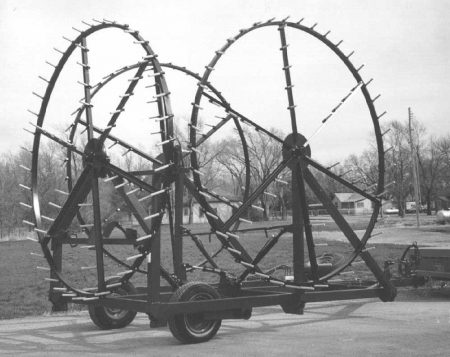
"You can run it at speeds up to 12 mph and do a great job working up the seedbed," says Lee Roy Douglas, Douglas Welding & Machine, Inc., Kipp, Kan., about the new 30-ft. folding rotary harrow he introduced at the recent 3-I show near Great Bend, Kan.
Rotary harrows have been on the market for years but
Douglas says his is the first to have more than one wheel and the first to fold
for transport.
The new unit has three non-powered rotating wheels, two
in front and one in back. The perimeter of each wheel is equipped with 9-in.
long, replaceable steel spikes spaced 10 in. apart. Spikes also mount on six
spokes that radiate outward from the wheel hub. Depth is controlled by
hydraulically raising or lowering a pair of carrier wheels.
"It's great for seedbed preparation and other
jobs, such as tilling weeds out of recently seeded alfalfa," says Douglas.
"It works better than a conventional harrow because the spikes are
constantly moving instead of being dragged in a straight line. As a result they
disturb more ground and have a much better chance of killing weeds. Each wheel
has 70 spikes so they really chew up the ground. It'll pulverize gopher mounds.
You can let the wheels down as little as one inch or lift them up all the way
and put the entire weight of the machine on the ground. When you sink the rings
into the ground it'll pull dirt along which you can use to fill in low spots.
"One farmer used the machine to reseed his CRP
ground. He burned the vegetation first, then broadcast seed and used the harrow
to mix the seed into the soil. The machine can even be used on milo and corn
stalks without plugging up. The key is to run the machine level so that all
three wheels keep turning. It doesn't work well on hilly ground, however.
"To replace the spikes all you do is pull a pin
and drop the old spike out, then pin the new one in," says Douglas.
Douglas says he got the idea for the 3-wheel model
after repairing a commercial single wheel model for area farmers. "The
spikes on that machine are welded on so if they break you have to weld new ones
on. Farmers kept telling me they wished they had a bigger, heavier-built model
with the capability to control depth. The rings on my wheels are made from 1
1/2-in. wide, 3-in. high, 3/16-in. thick rectangular steel tubing that's been
rolled into a circle so they'll take a lot of abuse. It's built heavy -- all the
wheels turn on 4,500-lb. spindles and hubs.
"My machine does pull surprisingly hard because it
moves a lot of dirt. It takes a tractor with at least 125 hp to pull my 30-ft.
model. I also make a 22-ft. model that can be pulled by a smaller
tractor."
